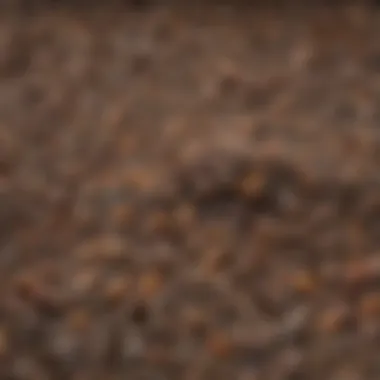A Comprehensive Guide to Scott's Springtime Fertilizer


Intro
Scott's Springtime Fertilizer serves as a fundamental component for garden enthusiasts aiming for lush and vibrant plants. Fertilizers play an essential role in effective gardening. They provide necessary nutrients that plants require for growth and vitality. This guide delves into Scott's offerings, specifically their Springtime Fertilizer, which is tailored to meet the demands of various flowering plants and verdant landscapes.
Understanding its composition is crucial. The formulation typically includes elements such as nitrogen, phosphorus, and potassium. These nutrients directly influence plant health and development. Depending on specific needs, proper application techniques can vastly improve results. Throughout this article, we will cover important aspects, including its application methods and the advantages it provides for different ornamental and vegetable plants.
In this exploration, readers will gain insights on how to apply this fertilizer effectively. Additionally, we will elaborate on its specific benefits for broad categories of plants. \nAiming to equip gardening enthusiasts with comprehensive knowledge, this guide will navigate through practical use options that lead to successful cultivation efforts during the spring season.
Foreword to Scott's Springtime Fertilizer
Scott's Springtime Fertilizer serves as an essential element in the toolkit of any dedicated gardener. This specific fertilizer has been designed to support plant growth in the spring season, when many plants are awakening from dormancy and require substantial nutrients. Proper fertilization during this time can lead to a healthier garden, vibrant blooms, and bountiful harvests. Furthermore, understanding this fertilizer's unique formulation and benefits lays a solid foundation for improved gardening practices.
One of the most important aspects of Scott's Springtime Fertilizer is its balanced nutrient composition. It provides the necessary macro and micronutrients that plants need in their early growth stages. These fertilizers typically contain nitrogen, phosphorus, and potassium, each serving a distinct purpose in nurturing healthy plants. Nitrogen, for instance, promotes leafy growth, while phosphorus supports root development and flowering.
Beyond nutrient composition, the application methods offered by Scott's are designed for ease of use. Homeowners and gardening enthusiasts can consistently apply the fertilizer in a way that maximizes its effectiveness. For example, the granulated form allows for uniform distribution, ensuring that nutrients reach the roots, where they are most needed.
In addition to supporting plants directly, the use of Scott's Springtime Fertilizer also carries ecological consideration. Its formulation aims to minimize runoff and environmental impact, making it a choice that aligns with more sustainable gardening practices. This aspect is increasingly pertinent as concerns regarding environmental preservation become more pressing.
"Using fertilizers like Scott's during spring can transform any garden into a lush oasis, balancing nutrition with eco-friendly practices."
In summary, Scott's Springtime Fertilizer represents a strategic approach to gardening that can significantly impact plant health and growth. Taking the time to understand its composition and application nuances can elevate the gardening experience, ensuring that it is both rewarding and environmentally conscious.
Understanding Fertilizers
Fertilizers play a pivotal role in plant health and garden productivity. They provide essential nutrients that soil often lacks, ensuring plants receive what they need to thrive. Understanding fertilizers helps gardeners make informed decisions about what to use for their specific gardening needs. This knowledge informs practices that enhance plant growth, improve soil structure, and support sustainability in gardening.
The Science Behind Fertilizers
The science of fertilizers is rooted in chemistry and biology. Fertilizers supply crucial elements like nitrogen, phosphorus, and potassium. These elements are often abbreviated as N-P-K and are vital for plant growth.
- Nitrogen (N) is essential for foliage growth. It helps in the synthesis of proteins and chlorophyll, leading to lush, green leaves.
- Phosphorus (P) supports root development and flowering. It is crucial during the early growth phase and encourages strong plants.
- Potassium (K) enhances overall plant functions, helping resist diseases and facilitating water retention.
Fertilizers come in both organic and inorganic forms. Organic fertilizers, such as compost, release nutrients slowly and improve soil quality over time. On the other hand, inorganic fertilizers often deliver nutrients more quickly but can lead to nutrient runoff and environmental concerns if not used wisely. Therefore, understanding the balance between these types is key for any gardener.
Types of Fertilizers
Fertilizers can be classified in several ways based on their composition, source, and application method. Here are the main types:
- Granular Fertilizers: These are solid fertilizers made in pellet or granule form. They release nutrients slowly, providing a steady supply over time. Scott's Springtime Fertilizer falls into this category, combining convenience with efficiency.
- Liquid Fertilizers: These fertilizers are mixed with water and applied directly to the soil or foliage. They work quickly and are often used for immediate nutrient needs.
- Slow-Release Fertilizers: These fertilizers are designed to release nutrients gradually. They are ideal for situations where long-term feeding is desired without frequent applications.
- Organic Fertilizers: Derived from plant or animal matter, these fertilizers improve soil health while providing necessary nutrients. Examples include manure, bone meal, and seaweed extracts.
- Synthetic Fertilizers: These are chemically manufactured and offer precise nutrient ratios. While effective, they can sometimes lead to nutrient imbalances and environmental issues if mismanaged.
Understanding the differences in fertilizer types is crucial for selecting the right product for specific gardening needs. Proper application enhances the efficacy of fertilizers and contributes to healthier, blossoming gardens.
What Makes Scott's Springtime Fertilizer Unique
Scott's Springtime Fertilizer stands out due to its specific formulation tailored for spring gardening needs. Unlike many generic fertilizers, this product is designed to promote early plant growth and strengthen root systems during the critical spring season. Understanding what makes Scott's Springtime Fertilizer unique is essential for homeowners and gardening aficionados seeking effective growth solutions for their plants.
Nutrient Composition
The nutrient composition of Scott's Springtime Fertilizer is a key factor that differentiates it from other products on the market. It typically features a balanced ratio of nitrogen, phosphorus, and potassium. Known as the N-P-K ratio, this balance plays a vital role in supporting plant health. The nitrogen aids in green leafy growth, phosphorus contributes to root development and flowering, while potassium enhances overall plant vigor.
Furthermore, Scott's Fertilizer often includes micronutrients like iron and magnesium, which are essential for preventing deficiencies that can hinder plant growth. This comprehensive approach ensures that plants receive the nutrients they need at the onset of the growing season, making it a preferred choice for both seasoned gardeners and novices.
Eco-Friendly Practices
Eco-friendliness is increasingly becoming a consideration for consumers. Scott's Springtime Fertilizer incorporates several sustainable practices that are beneficial for both gardens and the environment. For example, the fertilizer may use organic materials or be derived from natural sources, minimizing the impact on soil health and groundwater.
Additionally, Scott's emphasizes responsible application practices. By providing clear guidelines and recommendations for usage, the company helps prevent over-fertilization, which can lead to runoff and pollution. These considerations not only make Scott's product safer for the immediate ecosystem but also enhance its appeal to environmentally-conscious consumers.
In summary, Scott's Springtime Fertilizer is notable for its well-rounded nutrient composition and commitment to eco-friendly practices. This combination contributes to the fertilizer's effectiveness, paving the way for healthier gardens while also respecting environmental needs.
"A unique fertilizer product needs to balance effectiveness with sustainability, which Scott's does elegantly."
By understanding these unique characteristics, gardeners can make informed decisions that benefit their plants and promote responsible gardening practices.
Application Techniques for Optimal Results
Understanding effective application techniques is essential for maximizing the benefits of Scott's Springtime Fertilizer. Proper application not only enhances the impact of the fertilizer but also ensures that plants receive the nutrients they need without the risk of damage or waste. Different factors, including timing and method of application, play critical roles in achieving optimal results.
Timing of Application
The timing for applying Scott's Springtime Fertilizer significantly affects plant growth. Applying the fertilizer too early can lead to nutrient runoff, while applying it too late might not provide the nutrients needed for vigorous growth. It is crucial to align the application with the growing season of your plants.
Spring is the most suitable time as plants begin to emerge from dormancy.
Key considerations for timing are:


- Soil Temperature: Fertilizer should be applied when soil temperatures are warming, ideally above 50°F (10°C).
- Plant Growth Stages: Apply the fertilizer just before critical growth stages, such as flowering or fruiting.
- Weather Conditions: It’s best to fertilize before rain, as moisture helps in nutrient absorption.
By paying attention to these factors, homeowners can ensure that Scott's Springtime Fertilizer is used effectively to enhance plant vitality.
Method of Application
The method of application is equally important to ensure that Scott's Springtime Fertilizer is distributed evenly and efficiently across your garden or lawn. Different methods cater to specific garden setups and plant types.
Here are some common methods:
- Broadcasting: This technique involves spreading the fertilizer evenly across the soil surface. It is suitable for larger areas like lawns where uniform coverage is desired.
- Drip Fertilization: A method that integrates fertilizer application through irrigation systems. This allows for targeted feeding, reducing waste and runoff.
- Foliar Feeding: Spraying a diluted fertilizer solution directly on the leaves. This method is useful for quick nutrient uptake, especially when plants show signs of deficiencies.
Proper application methods can significantly enhance the efficiency of Scott's Springtime Fertilizer, reducing waste and ensuring that nutrients reach where they are needed most.
Finally, it is essential to follow the guidelines on the package. Compliance with recommended application rates helps avoid common mistakes like over-fertilization, which can harm both plants and the surrounding environment. Adopting careful timing and appropriate methods will lead to better gardening outcomes.
Benefits of Using Scott's Springtime Fertilizer
Using Scott's Springtime Fertilizer presents numerous advantages that can significantly enhance the gardening experience. When choosing a fertilizer, it is critical to consider its specific benefits, especially in relation to plant growth and soil vitality. This section will elucidate how Scott's formulation responds to the needs of different plants in various environments, resulting in improved outcomes for gardeners aiming for a flourishing garden.
Enhanced Plant Growth
One of the primary benefits of using Scott's Springtime Fertilizer is its ability to promote enhanced plant growth. The formulation is tailored to provide a balanced mix of essential nutrients, primarily nitrogen, phosphorus, and potassium. These nutrients play a crucial role in various physiological processes such as photosynthesis, root development, and flowering.
When applied at the right time, Scott's fertilizer can lead to:
- Greater biomass production: Plants treated with this fertilizer tend to have a significantly higher growth rate, leading to lush foliage and robust flowers.
- Improved resilience: Nutrient-rich plants are generally more resilient to pests and diseases, enabling healthier growth.
- Higher yield for edible plants: For gardeners growing vegetables or fruits, using Scott's fertilizer may result in a more plentiful harvest.
Regular application helps meet the nutritional demands of plants as they enter their most active growing phase during spring. As a result, the comprehensive nutrient profile ensures that plants receive not just one but all the key elements for optimal growth.
Improved Soil Quality
Another significant advantage of using Scott's Springtime Fertilizer is its contribution to improved soil quality. Healthy soil is the foundation of a successful garden, supporting plant health and productivity. The fertilizer aids in enhancing the physical and chemical properties of the soil over time.
Key aspects of soil improvement include:
- Increased organic matter: Many formulations, including Scott's, incorporate organic content that enriches the soil structure. This helps retain moisture and nutrients more effectively.
- Balanced pH levels: Fertilizers can help maintain appropriate pH levels, which is essential for the availability of nutrients to plants. Scott's products often contain buffers that facilitate this.
- Microbial activity: The nutrients and organic materials in Scott's fertilizer promote beneficial microbial life. This aids in decomposition and nutrient cycling, which are vital for sustaining soil health.
In summary, the use of Scott's Springtime Fertilizer not only supports immediate plant growth but also contributes to a robust soil ecosystem that benefits gardens in the long term.
"Healthy soil is the cornerstone of effective gardening. Investing in quality fertilizers like Scott's nurtures both plants and soil."
Fertilizers offering these benefits are critical to achieving a garden that not only survives but thrives throughout the spring and beyond.
Spring Gardening Techniques
Spring gardening is an essential aspect of cultivating a fruitful and vibrant garden. The arrival of spring marks a period of renewal, where soil comes alive and plants begin to flourish. Getting the techniques right during this phase can lay a solid foundation for the entire growing season. This section will explore two fundamental spring gardening techniques: preparing your garden and selecting the right plants.
Preparing Your Garden
To effectively prepare your garden for the spring season, understanding soil health is crucial. Healthy soil is the cornerstone of any successful gardening endeavor. Start with testing the soil to assess its pH levels and nutrient content. Soil tests can reveal what amendments are needed, be it lime for acidity or organic matter to boost nutrition.
Next, clear the garden area of any debris or dead plant material leftover from the winter months. This not only improves aesthetics but also reduces the risk of pests and diseases. Incorporating compost or well-rotted manure into the soil can greatly enhance its quality. As you work the soil, ensure it is loose and crumbly. This promotes good drainage and root penetration.
When your garden is ready, consider using a mulching technique. A layer of organic mulch can suppress weeds, retain soil moisture, and gradually enrich the soil as it decomposes. This practice not only economizes water but also shields plants during fluctuating temperatures.
Selecting the Right Plants
Choosing appropriate plants is another critical aspect of spring gardening. This decision directly impacts the garden’s overall success and maintenance requirements. Start by assessing your local climate. Different plants thrive under varied conditions, including temperature and rainfall. Researching the hardiness zone of your region can guide which species will thrive.
Once you have a grasp of local conditions, consider the following factors when selecting plants:
- Sunlight Requirements: Determine how much sun each area of your garden receives daily. Some plants need full sun, while others may thrive in partial or full shade.
- Soil Type: Different plants have distinct soil preferences, whether sandy, clay, or loamy. Match plants to their suitable soil types to ensure robust growth.
- Space Considerations: Take into account the mature size of the plants. Proper spacing enhances air circulation and minimizes disease risk.
"Selecting the right plants is as vital as preparing your soil. Each component plays a crucial role in the harmony of your garden."
Lastly, consider perennial varieties along with annuals. Perennials often require less maintenance once established, which can save time in the long run. Annuals, while providing immediate color and interest, usually need replanting each year.
By focusing on these spring gardening techniques, you set the stage for a successful growing season, maximizing the benefits of Scott's Springtime Fertilizer for your plants.
Common Mistakes in Fertilizing
Understanding common mistakes in fertilizing is crucial for maximizing the effectiveness of Scott's Springtime Fertilizer. Homeowners and gardening enthusiasts often face challenges that can hinder the growth and health of their plants. By recognizing and addressing these common errors, one can enhance their gardening experience and achieve better results. Careful fertilization contributes greatly to vibrant gardens, making it vital to Delve into these mistakes.
Over-Fertilization


One of the most prevalent mistakes gardeners make is over-fertilization. Many think that more fertilizer will lead to better growth, but this is a misconception. Applying too much fertilizer can result in nutrient burn. This condition damages plants, leading to yellowing leaves or even loss of foliage.
Another issue with over-fertilization is that it can disrupt the balance of nutrients in the soil. When excess fertilizer is present, the plants may absorb too much of certain nutrients while neglecting others, leading to nutrient deficiencies. Additionally, runoff from over-fertilizing can contaminate local water sources.
To avoid this mistake, it is essential to follow the recommended application rates for Scott's Springtime Fertilizer. Regularly testing the soil can also help to determine the fertility needs of your garden. By being informed, gardeners can ensure they provide the right amount of nutrients without causing harm.
Ignoring Soil Health
Ignoring soil health is another critical mistake. Many gardeners focus solely on the fertilizer they apply, neglecting to assess the condition of the soil itself. Healthy soil contains a diverse community of organisms and a balanced composition of nutrients necessary for plant vitality.
When the soil is neglected, it can become compacted or depleted of vital elements. This condition can lead to poor plant growth, despite adequate fertilization.
To mitigate this, it is important to invest in soil testing. Knowing the pH level and nutrient content will guide gardeners in selecting the right type and amount of fertilizer. Adding organic matter, such as compost, boosts soil health, promotes microbial life, and improves nutrient retention. Remember, a strong foundation in soil health directly translates to robust plants.
"Healthy soil is the backbone of a successful garden; never overlook its importance."
By understanding these common mistakes in fertilizing, gardeners can make informed decisions that cultivate health and vitality in their growing spaces. Emphasizing proper fertilization techniques along with maintaining soil health will undoubtedly lead to a flourishing garden.
Customer Reviews and Feedback
Customer reviews and feedback play a crucial role in shaping perceptions about Scott's Springtime Fertilizer. They provide valuable insights into real-world effectiveness and user experiences. Positive and negative reviews can highlight the strengths and weaknesses of the product, allowing potential buyers to make informed decisions.
In gardening, where success often relies on specific conditions, the collective experiences of other gardeners can serve as a guide. Reviews contribute to a communal knowledge base, offering practical information that can enhance the utilization of Scott's fertilizer. This feedback loop helps future users understand what to expect and how to maximize the benefits of the product.
Moreover, the inclusion of customer feedback serves to build trust in the brand itself. Responding to critiques and engaging with consumers demonstrates that Scott's is committed to quality and customer satisfaction. Together, these aspects create a more transparent relationship with potential buyers.
Positive Experiences
Many users of Scott's Springtime Fertilizer have shared positive feedback about the product. They often emphasize notable improvements in plant health, including increased growth rates and vibrant blooms. Satisfied customers mention that their gardens flourished after using the fertilizer, resulting in stronger and more resilient plants.
Several reviews indicate that the easy application process is one of the key reasons for their satisfaction. Users appreciate how simple it is to integrate Scott's fertilizer into their gardening routines. Some have expressed that they witnessed visible changes in their gardens within a few weeks of application.
"After using Scott's Springtime Fertilizer, my roses blossomed like never before. The improvement in color and health is remarkable!"
Additionally, customers often report that the fertilizer does not leave behind a messy residue, making clean-up straightforward. Many highlight its ability to prevent weed growth while promoting the health of desirable plants. This dual action provides a notable advantage in maintaining a well-kept garden.
Critiques and Suggestions
While many provide positive reviews, some users have shared critiques and suggestions for improvement. Common concerns revolve around the cost of Scott's Springtime Fertilizer. Users have stated that while the product is effective, they wish it were more competitively priced. This feedback can provide valuable insight for Scott's marketing and pricing strategies moving forward.
Some customers have also mentioned that they expected clearer instructions regarding application rates. They suggested that providing specific guidelines for different plant types would enhance user experience. Users emphasized how tailored recommendations could help gardeners optimize results, particularly for those new to gardening.
Lastly, a few reviews indicate a desire for additional eco-friendly certifications. As sustainability grows in importance, customers have expressed that they would appreciate seeing more transparency regarding the environmental impact of the ingredients used in Scott's fertilizer.
Overall, while positive experiences dominate the reviews, constructive critiques can further enhance Scott's product offerings.
Comparative Analysis with Other Fertilizers
A comparative analysis of Scott's Springtime Fertilizer with other fertilizers in the market is essential for gardeners seeking the most effective options for their plants. Understanding this comparison can highlight specific benefits, strengths, and considerations to aid in making informed choices. The effectiveness of chosen fertilizers can greatly impact plant health, growth rate, and yield, making this topic vital for anyone passionate about gardening.
Scott's vs. Competitors
When placing Scott's Springtime Fertilizer alongside its competitors, several aspects come into play. One critical element is the nutrient formulation. Scott's typically boasts a balanced ratio of nitrogen, phosphorus, and potassium (NPK) that aligns well with springtime gardening needs. In contrast, other brands may focus on one nutrient more heavily, which might not support overall plant health as effectively.
Another area to consider is the granule size and release mechanism. Scott's has devised slow-release formulas, allowing nutrients to be gradually absorbed. This slow-release technology reduces the risk of nutrient runoff and ensures a steady supply of vital nutrients over time. Other fertilizers, particularly fast-release options, may cause a quick surge in growth but can lead to nutrient leaching and potential harm to plants if not monitored closely.
"Choosing the right fertilizer is not just about the immediate effects; it's about long-term plant health and soil vitality."
Furthermore, the ecological impact cannot be overlooked. Scott's incorporates more sustainable practices in their formulation. Many competing products still rely on high levels of synthetic chemicals, which can disrupt local ecosystems.
Finally, price also weighs heavily in this comparison. While Scott's may be slightly more expensive than some competitors, garden enthusiasts often find that the quality justifies the cost. Choosing a product that may foster healthier growth and better soil sustainability often outweighs the initial investment.
Market Position
Scott's Springtime Fertilizer occupies a distinct market position within the gardening industry. Its reputation is built on quality and reliability, making it a preferred choice among gardeners. Competitive analysis reveals that while several brands have emerged, Scott's consistently holds a strong share in the segment focused on spring gardening.
Additionally, Scott's invests heavily in research and development, which contributes to its strong market position. This focus on innovation leads to new, more effective formulations that adapt to changing gardening needs. Other brands may sometimes lag in incorporating customer feedback into their products, allowing Scott's to leverage its insights for continuous improvement.
In summary, the comparative analysis underscores the value of Scott's Springtime Fertilizer. It showcases how thoughtful formulation, gradual nutrient release, ecological awareness, and market responsiveness contribute to its standing as a leader in the gardening fertilizer market. This analysis not only informs consumers but also demonstrates the importance of choices made when selecting a fertilizer for their gardens.
Sustainability Considerations in Fertilizer Use
Sustainability in fertilizer use is becoming increasingly significant as gardening enthusiasts recognize the impact their choices have on the environment. Scott's Springtime Fertilizer, like many modern fertilizers, is designed with sustainability in mind. This section will detail the various environmentally friendly practices and the long-term benefits that contribute to a healthier ecosystem while enhancing garden health.
Environmentally Friendly Approaches


The paradigm of gardening is shifting towards environmentally sound practices. Scott's Springtime Fertilizer incorporates natural and organic ingredients in its formulation, reducing the reliance on harsh chemicals. By selecting products with sustainable sourcing and green certifications, gardeners can support eco-friendly production methods.
Moreover, utilizing slow-release formulas minimizes nutrient runoff into waterways. This slow release not only nourishes plants over an extended period but also lessens potential pollution caused by excess fertilizers entering storm drains. When using Scott's fertilizer, it is advisable to apply the right amount at the right time to maximize its benefits without harming the environment.
Furthermore, adopting practices such as composting and mulching can complement the use of fertilizers. These strategies improve soil structure and biodiversity, reducing the need for chemical inputs.
Long-term Benefits for Gardens
Investing in sustainable fertilizer options yields long-term gains for gardens and surrounding ecosystems. The use of Scott's Springtime Fertilizer fosters healthier soils over time, as it encourages microbial activity, which is vital for nutrient uptake. Healthier soils support robust plant growth and resilience against pests and diseases.
As gardens thrive, they contribute to the local ecosystem's health by supporting pollinators and other beneficial organisms. A flourishing garden can act as a habitat, enriching biodiversity. Additionally, sustainable practices lead to improved water retention in the soil, reducing the need for frequent irrigation and helping to conserve water resources.
"Sustainable gardening is not just a trend; it's a necessity. Every decision we make has a direct impact on our ecosystems."
By prioritizing environmentally friendly approaches and understanding their long-term impacts, gardeners can enhance their cultivation efforts while advocating for a greener planet.
Expert Tips for Effective Spring Gardening
Effective gardening during the spring season requires a thoughtful approach, incorporating various practices alongside the use of fertilizers. The use of Scott's Springtime Fertilizer can significantly enhance plant health and yield, but its effectiveness can be maximized when combined with other gardening techniques. Here, we delve into the most effective methods to ensure a thriving garden, focusing on combining fertilizers with complementary practices and monitoring plant health for optimal results.
Combining Fertilizers with Other Practices
The integration of Scott's Springtime Fertilizer with other practices is essential for achieving excellent results in your garden. Fertilizers alone cannot address all plant needs. For instance, soil preparation plays a critical role. Before applying fertilizer, ensure the soil is adequately aerated and enriched with organic matter. This step helps in nutrient absorption.
In addition, consider using mulching. Applying mulch around plants retains soil moisture and regulates temperature. This practice, combined with the nutrients from Scott's Springtime Fertilizer, creates an ideal environment for plant growth.
Moreover, implementing crop rotation can reduce soil nutrient depletion and pest infestations. This practice also prevents the overuse of the same nutrients and supports a healthier ecosystem in your garden.
Regular soil testing can guide you in using fertilizers more effectively. By knowing the nutrient levels in your soil, you can determine the right amount of Scott's Springtime Fertilizer needed for specific plants. Thus, combining fertilizers with practices tailored to your garden’s conditions can dramatically improve yields.
Monitoring Plant Health
Monitoring plant health is another fundamental aspect of spring gardening. Observing your plants helps identify nutrient deficiencies, pests, or disease symptoms early on. This proactive approach allows for timely interventions, ensuring that plants receive the care they need.
Visual inspection is a basic yet crucial monitoring technique. Look for changes in leaf color, size, or texture. These can signal nutrient imbalances. For example, yellowing leaves might indicate a nitrogen deficiency, suggesting a need for additional Scott's Springtime Fertilizer or an alternative nutrient source.
Additionally, be attentive to growth patterns. Stunted growth may require adjustment in your fertilization schedule or methods. The timing of fertilizer application influences how well plants can absorb nutrients. Thus, regular stops in the garden to assess growth can lead to more informed decisions.
Utilizing plant health apps and tools can enhance your monitoring efforts. These resources can track growth rates and even provide reminders for fertilization schedules based on the specific needs of plants in your garden.
In summary, incorporating these expert tips on combining fertilizers with other practices and monitoring plant health can significantly enhance your gardening experience. Using Scott's Springtime Fertilizer is one key component, but the overall success of your gardening efforts relies on a well-rounded approach.
Future Trends in Gardening Fertilizers
The landscape of gardening fertilizers is continually evolving. Understanding these trends is crucial for anyone looking to stay ahead in gardening practices. Innovations and consumer shifts are redefining how fertilizers are formulated and utilized. As gardeners aim for greater efficiency and sustainability, knowledge of future trends becomes indispensable. This section will cover the latest innovations in fertilizer development and shifts in consumer preferences, providing a comprehensive overview of where the industry may be headed.
Innovations in Formula Development
Recent advancements in formula development are transforming the fertilizer market. Companies are focusing on science-backed formulations. These innovations can lead to more effective nutrients released at the right time for plants. For instance, slow-release fertilizers are gaining traction because they provide a steady supply of nutrients over extended periods. This method reduces the frequency of application and can improve plant health.
Additionally, many brands are incorporating biological components into their products. Microbial fertilizers are one such example. These fertilizers boost soil ecology, helping to improve nutrient uptake by plants. Such formulation innovations align with increased awareness of sustainability within gardening practices.
"Innovative fertilizers can enhance plant health while conserving resources through efficient nutrient delivery."
More research is being dedicated to understanding how plants absorb nutrients. This knowledge aids in creating formulas that better cater to specific plant types. Customizable fertilizers based on soil tests are becoming more common as gardeners seek tailored solutions to optimize growth.
Shifts in Consumer Preferences
Consumer preferences in the gardening sector are shifting significantly. Today’s gardeners are increasingly leaning towards environmentally friendly products. There is a marked rise in demand for organic fertilizers. Homeowners are aware of the environmental impact of conventional chemical fertilizers.
Furthermore, many consumers are seeking transparency in product labeling. They want to know the origin of nutrients and the methods used in formulation. This trend reflects a broader conscious shift toward sustainability and ethical consumption. Brands that respond to these needs may see a competitive advantage.
- Homeowners prefer products that have:
- Organic certifications
- Minimal synthetic ingredients
- Clear sourcing information
The impact of social media also cannot be ignored. Platforms like Reddit and Facebook host communities discussing gardening practices. This engagement influences consumer choices, driving demand for innovative and environmentally responsible fertilizing options.
In summary, staying abreast of future trends in gardening fertilizers will empower gardeners. Innovations in formula development, combined with shifts in consumer preferences, contribute to a more sustainable, efficient approach to gardening. Understanding these aspects not only enhances gardening practices but also supports broader environmental goals.
Culmination: The Role of Fertilizers in Gardening
Fertilizers are critical in gardening. They provide essential nutrients that plants need to thrive. The right fertilizer can significantly enhance plant growth, improve soil quality, and contribute to healthier gardens overall. Understanding how fertilizers work helps gardeners make informed choices, particularly when choosing a product like Scott's Springtime Fertilizer.
Scott's Springtime Fertilizer stands out for its balanced blend of nutrients. This specific formulation promotes vigorous growth during the spring, a key season for many plants. It delivers nitrogen, phosphorus, and potassium in the right amounts, catering to the needs of diverse plant types. Applying this fertilizer correctly can lead to improved flowering and fruiting, which are desired outcomes for many gardeners.
"The right fertilizer not only nourishes plants but also supports soil health, creating a sustainable ecosystem that benefits both horticulturists and the environment."
Homeowners and gardening enthusiasts should consider the timing and method of application. Spring is an ideal time for fertilizing since plants are emerging from dormancy and require additional nutrients to support their growth. Knowing when to apply Scott's fertilizer ensures maximum uptake by the plants, leading to optimal results.
Another aspect of the role of fertilizers is the importance of balancing nutrient levels. Over-fertilization can be detrimental, leading to nutrient run-off and harming local ecosystems. Using a well-formulated product like Scott's minimizes this risk while ensuring plants receive adequate nourishment.







